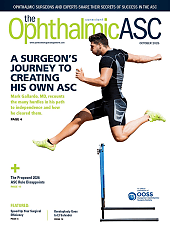4D Molecular Therapeutics announced positive initial interim 52-week data from the phase 2b Population Extension cohort of the PRISM clinical trial evaluating 4D-150 in a broad wet age-related macular degeneration (AMD) patient population. Additional data were provided on the durability of aflibercept expression for up to 2 years. The data were presented by Dante Pieramici, MD, in an oral presentation titled “Phase 2b Population Extension Cohort Evaluating 4D-150 in Neovascular Age-Related Macular Degeneration: 52-Week Results” at Angiogenesis, Exudation, and Degeneration 2025, the company said in a press release.
“We believe 4D-150 has paradigm-shifting potential. 4D-150 is designed to achieve favorable tolerability and robust and durable multi-year efficacy following routine intravitreal administration that enables seamless integration into retina clinics,” said David Kirn, MD, co-founder and CEO of 4DMT, in the press release. “The data from the PRISM clinical trial, which evaluated wet AMD patients with a broad range of disease severity and duration, and the initial data from SPECTRA in diabetic macular edema (DME), demonstrate 4D-150’s potential to become the first backbone therapy forming the foundation for the treatment of vascular retinal diseases. The ability to deliver disease control with long-lasting freedom from frequent bolus injections addresses the primary unmet need for patients and physicians.”
The topline 52-week efficacy results for 4D-150 3E10 vg/eye (planned phase 3 dose) from phase 2b population extension cohort of PRISM (Data Cut-Off Jan. 15, 2025):
- Phase 2b (n=30): Broad Wet AMD Disease Activity
- Supplemental aflibercept injections:
- 83% reduction, representing 0.97 mean supplemental injections per patient over 52-weeks vs 6.0 injections projected with on-label aflibercept 2 mg Q8W
- 70% 0-1 injection
- 57% injection-free
- Improved and maintained best-corrected visual acuity (BCVA) of +2.2 letters
- Durable central subfield thickness (CST) improvement with fewer fluctuations, as measured by optical coherence tomography (OCT), of -11 µm; -13 µm in supplemental injection-free patients
- Phase 2b (n=15): Recently Diagnosed Subgroup
- Supplemental aflibercept injections:
- 94% reduction, representing 0.33 mean supplemental injections per patient over 52-weeks vs 6.0 injections projected with on-label aflibercept 2 mg Q8W
- 87% 0-1 injection
- 80% injection-free
- Improved and maintained BCVA of +3.1 letters
- Durable CST improvement with fewer fluctuations, as measured by OCT, of -10 µm; -20 µm in supplemental injection-free patients
4D-150 safety update from PRISM (Data Cut-Off Jan. 15, 2025):
- 4D-150 continues to be well tolerated during up to 3 years of follow up in all patients treated with 3E10 vg/eye
- 2.8% (2 of 71) had 4D-150–related 1+ intraocular inflammation (IOI) (SUN/NEI scales), which were transient 1+ vitreous cells noted at a single timepoint, as previously reported
- 99% (70 of 71) completed steroid prophylaxis taper on schedule
- 99% (70 of 71) remained completely off steroids
- No 4D-150-related hypotony, endophthalmitis, vasculitis, occlusive/non-occlusive retinal vasculitis, or choroidal effusions observed to date
"The promise of 4D-150 for both patients and clinicians lies in its potential to tackle one of the most pressing unmet needs in vascular retinal diseases—providing a long-lasting, effective treatment option that reduces the frequent burden of bolus anti-VEGF injections,” said Dante Pieramici, MD, a principal investigator of the PRISM study and member of the 4DMT Ophthalmology Advisory Board. “4D-150 offers a profound shift in how we manage our patients’ care, potentially freeing them from the ongoing challenges of injection frequency while ensuring they maintain the vision improvement characteristic of current standard of care. The data from the PRISM study gives me great hope that 4D-150 can become the backbone of future retinal treatments for wet AMD, offering both clinical benefit and better quality of life for our patients."
PRISM durability update from all 3E10 vg/eye cohorts:
- Aqueous humor concentrations were studied serially every 3 months
- Durable and stable aflibercept expression demonstrated, with up to 2 years of follow-up, with aqueous humor concentrations consistently within projected therapeutic range
4D-150 program milestones:
- 4FRONT-1 and 4FRONT-2 expected to initiate in Q1 and Q3 2025, respectively
- 2-year phase 1/2a and 18-month phase 2b PRISM data expected in Q4 2025
- Primary endpoint 52-week topline data from both 4FRONT-1 and 4FRONT-2 expected in H2 2027








